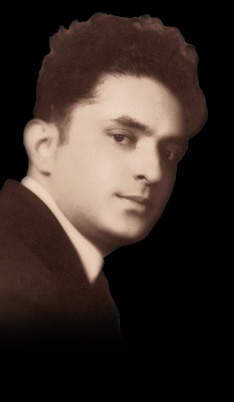

|
 |
Page 1 | Page 2 | Page 3 | Page 4 |
| Reflections |
| 1 |
AN ARTIST AND A SAGE
Among the giants of modern Cha'za'nut, Leib Glantz still stands out as a unique phenomenon; a synthesis of scholar, theoretician, composer and performer. This incredible coexistence of so many virtues in one individual is even more amazing if we understand that some of these virtues actually stood in contradiction to each other. The image of the composer and performer is the image of the artist: creative, imaginative, burning with desire to spread out his virtuosity. The image of the scholar is that of the sage: venerable, moderate, wary of foreign influences and innovation. Holding fast to established traditions, while at the same time looking forward for growth and progress of Cha'za'nut as an artistic and religious endeavor, typified Glantz’s career. He was the brilliant innovator and the formidable conservative. These seemingly incompatible contradictions are at the core of the present discussion of Leib Glantz's work and personality. |
| |
An excerpt from: Harmonizing Theory with Creativity: Cantor Leib Glantz’s Musical Agenda, by Amit Klein, Prof. Eliyahu Schleifer and Prof. Edwin Seroussi, The Jewish Music Research Centre of the Hebrew University, Jerusalem. |
| |
TOP |
| 2 |
GRANDEUR, SOLEMNITY AND "RIGHTNESS" FOR THE OCCASION
The underlying theme of Leib Glantz’s Bir’kat Ko’ha’nim (Priestly Benediction) simulates the lengthy wordless refrain that worshipers sing along with the cantor in traditional synagogues, after the Ko’ha’nim conclude each section of their tripartite blessing. The sources from which Glantz may have derived inspiration for his own noble four-part creation are documented. None of these sources approach the grandeur, solemnity and “rightness” for the occasion that Glantz had achieved in adapting them for his elaborate leitmotif. He plucked fragments of Nu’sach from the liturgy, biblical cantillation motifs from Ta’a’mei Mik’ra, idiomatic turns of phrase from Yiddish folk songs and Chasidic Ni’gu’nim. All of these elements he combined -- whether consciously or intuitively -- with “Mediterranean”-style Zionist paeans to the Land of Israel that were then being written by pioneer settlers in Palestine under the British Mandate. Glantz had always been an ardent and supportive member of Tze’i’rei Tzi’yon, a Labor Zionist youth organization that promoted A’li’ya, and their hymns may have provided the seed that begat his old/new chant for Bir’kat Ko’ha’nim.
|
| |
An excerpt from: The Glantz/Pinchik Conundrum, by Dr. Joseph A. Levine, Professor, the Jewish Theological Seminary and editor of the Journal of Synagogue Music. |
| |
TOP |
| 3 |
A STYLE OF HIS OWN
Although Glantz stemmed from a similar tradition of learning and exposure to the cantorial chants of the East European synagogue as his other talented colleagues and peers, nevertheless, he grew and developed his artistry in a style all his own, uniquely Glantzian. He elevated his creative efforts to an art form that other musicians and composers, of totally different genres of music, were drawn to appreciate and be inspired by the uniquely original performance of his own liturgical works. |
| |
|
| |
In our attempt to understand Glantz among the traditional school of cantor-composers of Jewish liturgical music one could compare him, in certain ways, to the great 20th century composer, Arnold Schoenberg (1874-1951). Schoenberg, considered one of the seminal figures of 20th century music was unique among the classic western composers of the 20th century. Just as Schoenberg loosened the grip of traditional tonality and explored new ways of working the 12 notes of the chromatic scales, Leib Glantz explored completely new tracks and paved a new path in rendering the “traditional” modes of East European liturgical song. Like Schoenberg, Glantz conceived and created a most original and revolutionary approach to the interpretation of the liturgical texts of the prayer book in ways never attempted before. |
| |
An excerpt from: “How Shall We Open Our Mouth Before Thee,” by Cantor Abraham Lubin, composer, educator, lecturer and researcher. Former editor of the Journal of Synagogue Music. |
| |
TOP |
| |
|
|
| Page 1 | Page 2 | Page 3 | Page 4 |
| |
|
|
|
| Copyright © 2007, by Dr. Jerry Glantz |
|
|